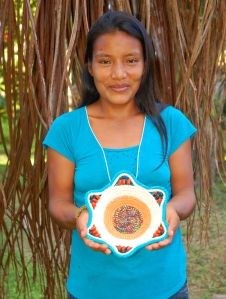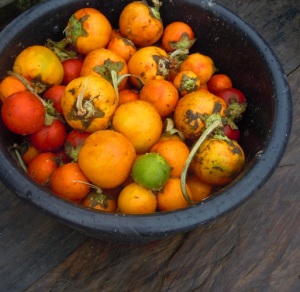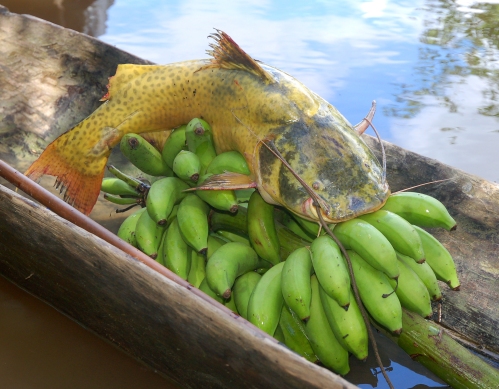by Campbell Plowden
Every time I go to Peru, I look forward to spending at least a few days in the campesino village of Chino on the Tahuayo River. I go there primarily to buy some of the beautiful baskets and other woven handicrafts made by women in the Huacamayo artisan cooperative. What makes these trips possible is that we enjoy an easy working relationship with the Rainforest Conservation Fund (RCF) to help arrange short stays at their lodge, meetings with artisans and leaders, and the purchase and delivery of materials for community projects funded with the CACE social rebate from craft sales. Finally, Chino is a very welcoming community in an incredibly beautiful place where I usually get to go fishing on a free morning.
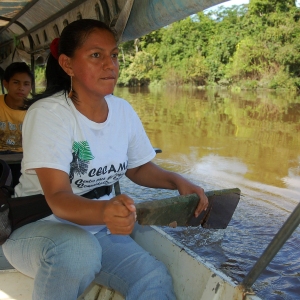
Yully Rojas paddling RCF boat with floorboard in 2010. Photo by Campbell Plowden/Center for Amazon Community Ecology
I have sometimes taken a small lancha from Iquitos to Chino (an 8 to 10 hour journey often shared with a boat full of people, chickens, fish and bags of charcoal), but Luke, Amrit and I were lucky that our friend Gerardo, an extension worker with RCF, was available and willing to take us there in their motorboat as long as we paid for the gas. While these trips are not guaranteed to be speedy (we once had to paddle the boat to a nearby village with floor boards when the engine conked out), we made it comfortably to Chino on this Tuesday without incident.
The rainy season was over, but water marks more than a foot above the already elevated first floor on the walls in the RCF lodge showed that this year’s floods had been very high for the second year in a row. In past visits, I’ve share the four bedroom space with as many as a dozen students from Grand Valley University doing an Amazon field course with RCF President Jim Penn, but this time, we had the place to ourselves with Gerardo. The house is no luxury eco-lodge, but having access to a flush toilet, cold shower, gas stove, a generator for light and laptop, and a bed covered with a mosquito net canopy was a welcome upgrade after much more rustic conditions in the Ampiyacu.

Campbell Plowden buying chambira basket from Chino artisan. Photo by Amrit Moore/Center for Amazon Community Ecology
We spent most the next two days watching the artisans and buying their handiwork. They have a well-deserved reputation for making a great variety of baskets woven with chambira palm fiber that has been dyed with a rainbow of local plants. I had bought many of these during past visits at a “feria” (fair) in the same simple building where coop members display their crafts to visiting guests from the Amazon Adventures lodge upriver. This time I had placed an advance order to buy dozens of woven frogs, particularly small ones designed as Christmas tree ornaments.
When arriving in Chino, I learned that my request for woven frogs had generated some confusion and discontent. The cooperative had split the order among interested members so the benefits would not be limited to the one artisan who had specialized in the making these frogs in the past. This division led to a fountain of new designs for woven frogs including the neat innovation of well-defined feet. See other photos of artisans with woven frogs. See photo album of Chino woven frogs on CACE Facebook page.

Orange woven frog ornament made by artisan from Chino, Peru. Photo by Campbell Plowden/Center for Amazon Community Ecology

Red woven “jewelry box style” frog with clasp. Photo by Campbell Plowden/Center for Amazon Community Ecology
Unfortunately some women did not make their first frogs with a pleasing shape or imbue them with the personality of their master creator. To compound this problem, the original frog lady had not understood the details of my order so she and her fellow artisans presented me with a squadron of larger than life bullfrogs and only one of the ornament sized peepers I had wanted as a tree ornament. I bought as many of the colorful mid to super-sized hoppers as I thought I could sell in the next few years with hopes that tourists would buy the rest in time. Few artisans left empty-handed, though, since I also purchased my usual quotient of 40 woven baskets and pots.
The lesson for me (that I learned the hard way three times the hard way this trip) and the artisans was very clear. Handicraft orders should include very specific dimensions and photos of the desired models. It is wrong to assume that just because someone has made something one year that they will remember how to make it the same way the next. That evening I did a slide show of all the baskets I had bought from Chino since 2008 and gave a CD copy of these images to Exiles (an RCF extension agent who lives in the community) to share with other artisans so they could see and replicate some of the stunning designs they have made in recent years. See sample photos of Chino baskets.
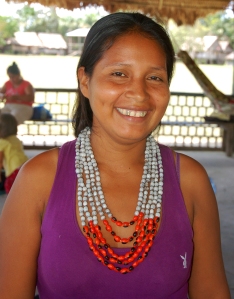
Chino artisan with rosario and huayruru seed necklace. Photo by Campbell Plowden/Center for Amazon Community Ecology
Chino artisans are also looking to expand their craft-making beyond weaving chambira. The day after the “feria,” most coop members gathered in the open-air common area (with a conical thatched roof) to practice making some complex necklaces with huayruru (Ormosia spp.) and rosario (Nothoscordum spp.) seeds. They used a hand drill mounted upward to drill a hole through the center of each seed and then strung them in patterns according to design specifications of a potential buyer. It was neat to see pairs of artisans working comfortably together to figure out the nuances of different models.

Amrit Moore drawing artisan with girl at Chino. Photo by Campbell Plowden/Center for Amazon Community Ecology
Amrit attracted the attention of girls and eventually a few boys as she sketched women stringing beads and weaving bags. She admired one multi-strand shiny red, black, and grey necklace so much that she asked Rosa to make a duplicate for her.
While most Peruvian artisans have many plants to dye chambira various shades of yellow, orange, red, and brown, it is surprisingly difficult to find green plants that can impart a durable green color to this otherwise receptive fiber. This visit to Chino, I was happy that two artisans left the necklace-making session to show me how they use leaves of pijuayo palm (Bactris gasipaes) and cocona (Solanum sessiliflorum) plants to dye chambira green. Both plants are common in home gardens and fields throughout the region, although their fruits are harvested more for food than dye.
Artisan Romelia Huanaquiri who had demonstrated other dye plants to me before escorted us to her backyard and used a pole saw to cut a long leaf hanging out from a modest-sized pijuayo palm tree and plucked the spear-like leaflets off the petiole (stiff central stem of the leaf). She then picked a handful of large plate size leaves from a cocona plant and brought them all back to her house. The next stages of processing both plants were the same. Romelia and her artisan colleague Lastemia took turns folding and smashing the leaves with a round smooth stone onto a large flat one.
Each batch of mashed leaves was then put into a pot with some water and a hank of clean chambira fiber to boil over a fire. Romelia removed the pot from the flame after ten to fifteen minutes, sifted out the chambira, and laid the strands on a table to dry in the shade. The pijuayo dyed chambira had a pleasant medium green tint while the cocona dyed batch seemed quite pale.

Romelia Huanaquiri soaking chambira with pijuayo. Photo by Campbell Plowden/Center for Amazon Community Ecology
Romelia said that it had probably needed a stronger concentration of leaves and longer time boiling. The main reason why Ampiyacu artisans said they didn’t use these plants was that the color in dyed in chambira faded too quickly if exposed to water or sun. We plan to do some controlled studies with these and other plant dyes to test their durability.
Luke, Amrit and I had a chance to go fishing with Exiles, but the best fish we had were from a couple of large striped (Psuedoplatystoma spp.) and yellow catfish that Gerardo had bought from a local Chino man who had been dropping his line in the water all night. As we enjoyed our supper of fresh doncella, we were also treated to a gorgeous rainbow over the Tahuayo River.
Last year, Chino had decided to use its social rebate funds from CACE sales of its crafts to build a basic bathroom for its school children. It took many months to complete, but I was very happy to see that the job had been done well. It was a two-stall wooden structure with basic toilets. A tube had been connected to the gutter from the school roof to funnel runoff water from rain into a large barrel that stood next to the bathroom doors. Kids would need to scoop water from this barrel with a bucket to flush the toilet.

Exiles from Rainforest Conservation Fund at new bathroom in Chino. Photo by Campbell Plowden/Center for Amazon Community Ecology
Luke made his own contribution to the kids in Chino by teaching English to the high school students for both days we were there. Teaching these classes in Chino and other villages was both inspiring for him and gave him an even deeper appreciation for the advantages of his education opportunities at home – benefits that many of his peers at his high quality public school take for granted.
The community meeting convened to decide how to use CACE social rebate funds from the past year of craft sales was due to start at the typical time of 7 pm. While it was a convenient time to gather after work and family dinners, it also coincided with the peak dinner time for mosquitoes. As people casually arrived, the growing assembly resembled an unchoreographed jerky dance as people randomly swatted their shoulders and thighs and stamped their feet. Within half an hour, Solis Zandromo, the Agente Municipal (top elected official in Peruvian villages) felt that a sufficient quorum of residents had arrived to proceed.

Gerardo Bertiz from Rainforest Conservation Fund helping to buy water pump for Chino bathroom. Photo by Campbell Plowden/Center for Amazon Community Ecology
I presented a brief summary of CACE craft sales from Chino and the amount now available. Proposals came from the floor to carry out various projects, but the group finally reached consensus on a plan to build a cement patio in front of the school so the kids could gather on a dry spot that was often pure mud. If there were sufficient funds, they would also upgrade the school bathroom with a larger tank on the roof so the toilets could be flushed at any time with water pumped from the river because there were often times in the dry season when there wasn’t enough rain to fill the barrel. I passed around a bag of buttered and salted popcorn to the attendees with appreciation for their reaching a decision before the mosquitoes totally devoured me.

Chino leader with water tank for bathroom. Photo by Campbell Plowden/Center for Amazon Community Ecology
Back in Iquitos, Gerardo and Solis shopped around for supplies at hardware stores and quickly concluded that we actually had enough budget to finance both projects. I didn’t feel a need to accompany them to buy cement for the patio, but it was fun joining them to purchase the giant water tank and test out the pump. I look forward to seeing the upgraded bathroom during my next trip to Chino in the summer of 2014.
Other photos from the trip to Chino

Girls playing on monkey bars at Chino. Photo by Campbell Plowden/Center for Amazon Community Ecology

Doncella catfish caught in the Tahuayo River. Photo by Campbell Plowden/Center for Amazon Community Ecology



